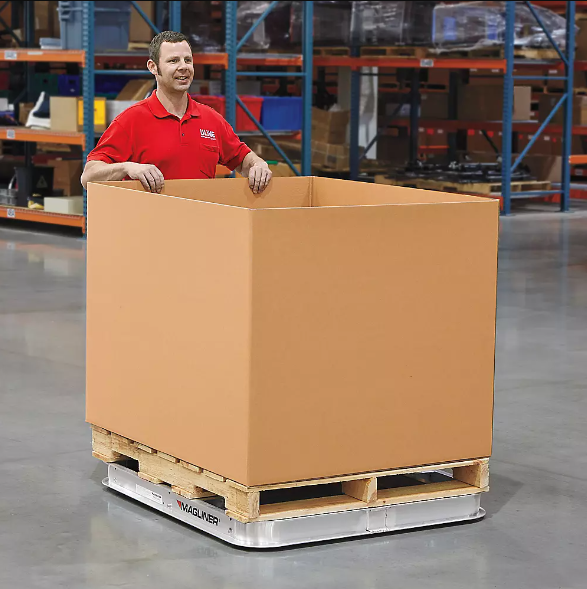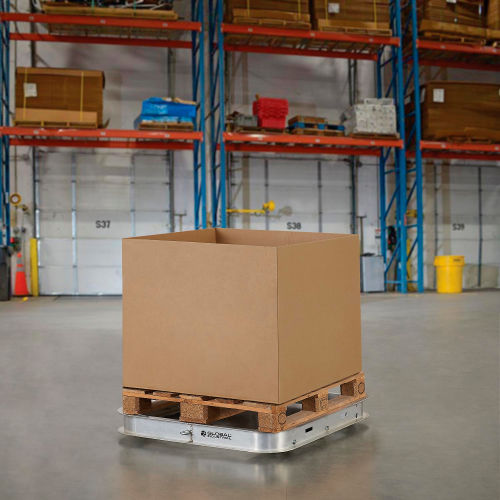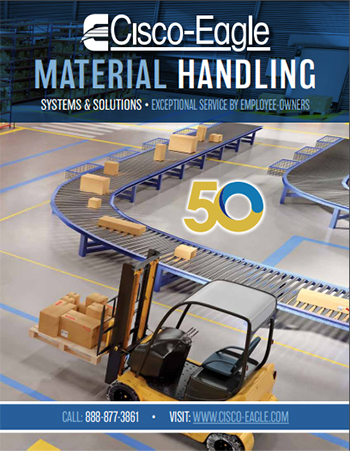Ensure Smoother Operations with Pallet Dollies
Improve workflow by adding this unsung transport hero
Pallet Handling Equipment Inquiry

The new age of material handling solutions is bringing many products once unheard of. Whether it’s an automated process designed to ease the burden on employees and improve throughput, or new safety features that increase awareness while removing danger, futuristic improvements are being adopted at an incredible rate.
There are, however, some tried and true methods of ferrying items from one area to another in a facility. Take the pallet dolly….a solution that’s been around forever and stood the test of time (and movement!).
Enter the pallet dolly
Pallet dollies are square or rectangular platforms designed to accommodate pallets for movement They are equipped with axles and rollers within the frame, enabling them to move with ease. Depending on their construction, pallet dollies can support pallets made of wood, metal, or plastic, and even handle slip sheet loads.
Pallet dollies can be propelled manually by pushing, or guided with the help of a rope, rod, or towing handle. If fitted for towing, they can be effortlessly pulled by a motorized device, such as a tugger cart.
Which industries/applications benefit most?
These analog improvements lend themselves to just about any facility or industry. There are, however, some specific environments where a pallet dolly shines.
Manufacturing
Pallet dollies prove invaluable in handling large parts bins or gaylord containers near machines. As parts are produced or assembled, they can be placed in the bin, which can be rolled away from the machine once full, making room for an empty bin on another pallet dolly. This eliminates downtime, as machine operators no longer have to wait for a forklift to move the full bin.
When equipped with a towing accessory, multiple pallet dollies can be linked together and towed by a tugger or forklift. This efficiency-enhancing practice reduces downtime across an entire facility, allowing material handlers to swap out multiple pallet dollies in one go, as opposed to servicing one machine at a time.
Warehousing and general storage
Within a warehouse, pallet dollies facilitate the seamless movement of floor-level inventory stored beneath racks. Bins or pallets of parts can be placed on the pallet dolly, which can then be smoothly slid out from beneath the lowest rack. When it’s time to store the bin or pallet again, it effortlessly slides back into place.
Food and beverage distribution
Think beer or soda cans (lol), but food as well. Moving ingredients or kegs to and from the processes involved at a facility can definitely be completed by a forklift, but what if you don’t have the space? By adding pallet dollies to these routes you can safely load and unload while also navigating congested corners or tight spaces. You can stack and stack food or beverage containers as well!
What specifications matter?

So you’re in, and ready to add a pallet dolly (or dollies more likely) to your operations. But what should you want to consider when choosing the right version to fit your facility?
Size first and foremost
Pallet dollies come in various lengths and widths, though they typically adopt square or nearly square dimensions. It’s imperative to understand the manufacturer’s definition of width and length, especially if the dolly needs to pass through a doorway. Clarify with the manufacturer to ensure it will fit in your intended location.
To turn or not turn, that is the question
The decision between a tilt or non-tilt version largely depends on whether you want your pallet dolly to turn….that is navigate corners. Tilting models have center rollers mounted lower than those at the ends, allowing it to tilt for cornering. This may reduce load capacity due to the uneven contact of rollers with the floor. If the dolly is expected to move solely back and forth, non-tilt models may be preferable, particularly if maximizing capacity is a priority.
Non-tilting options are not a lesser version but lend themselves to specific uses where front-to-back movement is key. Think accessing product beneath a rack, and the added ergonomic benefits that come from being able to bring a pallet from out of its bay.
Rolling numbers factor
The number of rollers significantly impacts the dolly’s capacity. More rollers mean a heavier load-bearing capability, so you want to consider that with each application you’re putting your pallet dolly in.
The type of rollers can also influence capacity and compatibility with accessories. Phenolic rollers are common due to their hardness, reducing the initial effort required to move the dolly. Thermoplastic polyurethane rollers are slightly softer and may have a reduced capacity. However, they are essential for pallet dolly towing systems, as they are less likely to develop flat spots when left stationary for extended periods. Towing a dolly with flat spots (or a series of them) can be excessively noisy.
While adding pallet dollies into a facility won’t bust a budget or necessarily be a major decision, matching your operations with one is a win! By factoring in your needs with which type will go with your flow, you can roll into improved transport and much more. Alright, I’m out of movement metaphors (whew!).
Download our catalog
At Cisco-Eagle, we pride ourselves on being a single source for your material handling needs with a long history of performance you can rely on. Because we also believe in empowering our customers with detailed information and options, we’re proud to offer the latest version of our company catalog.
Download the catalog today
Evan Fleishacker




